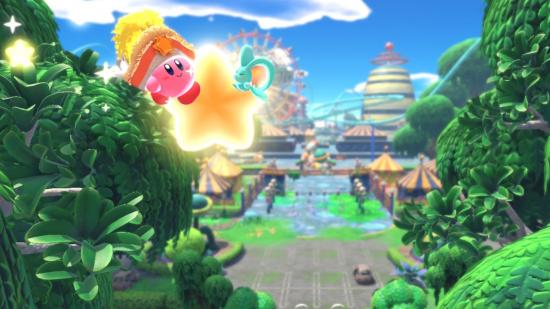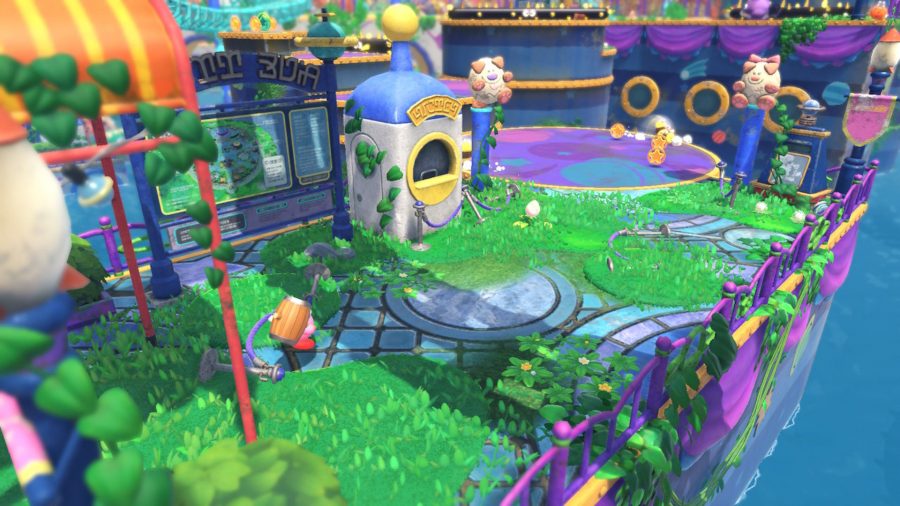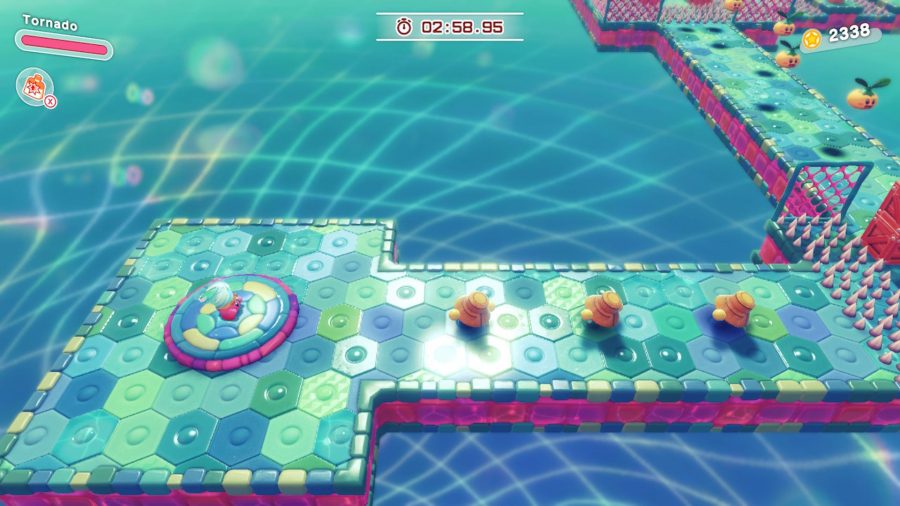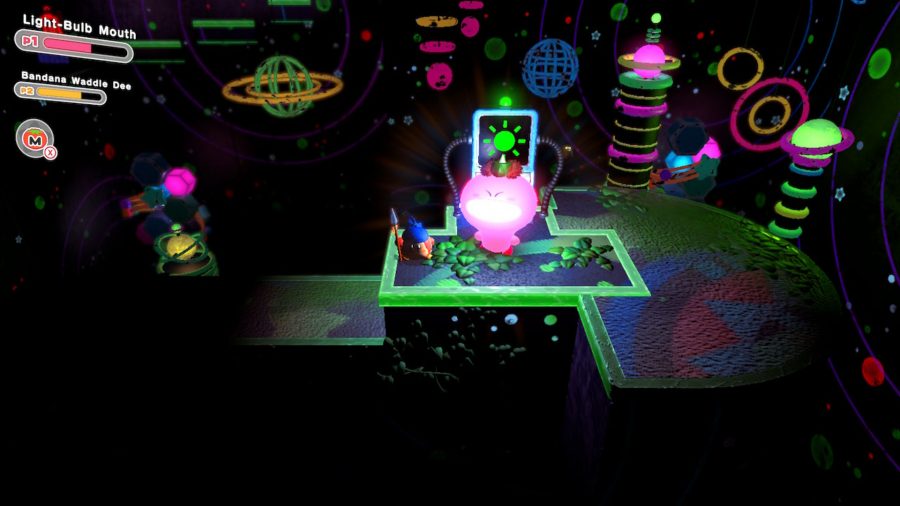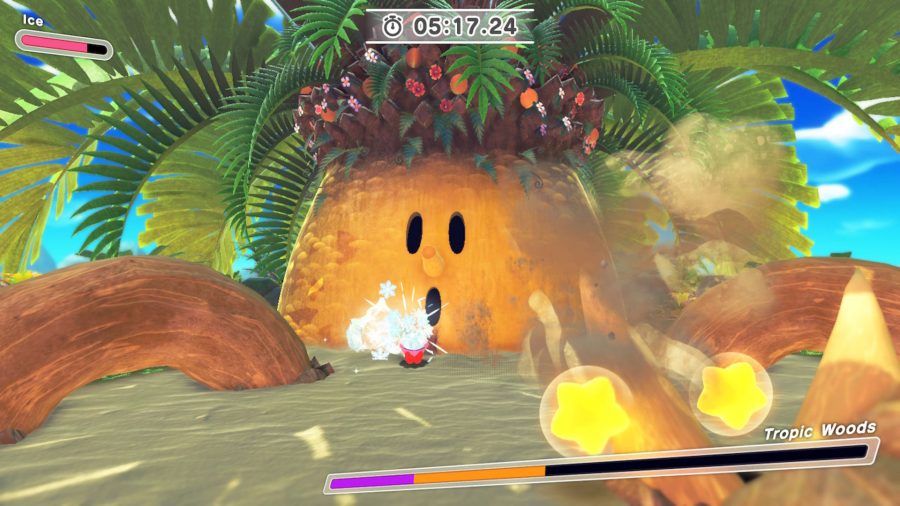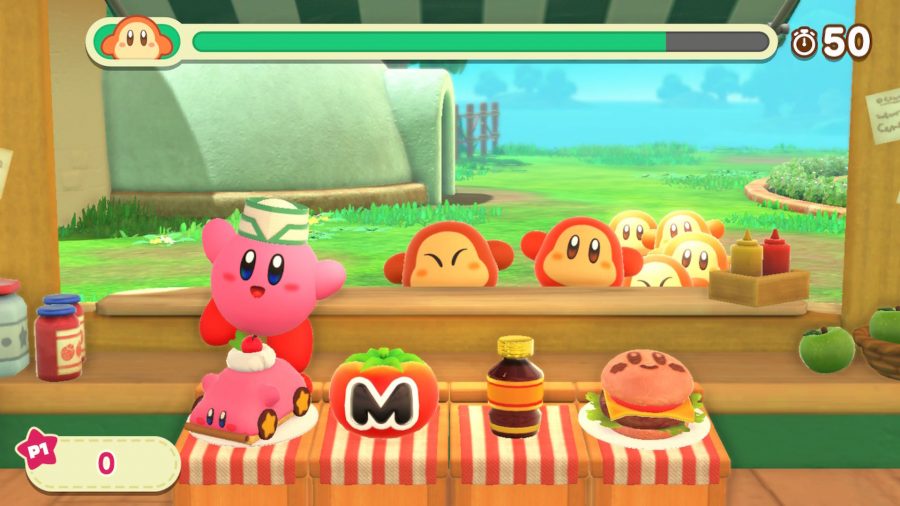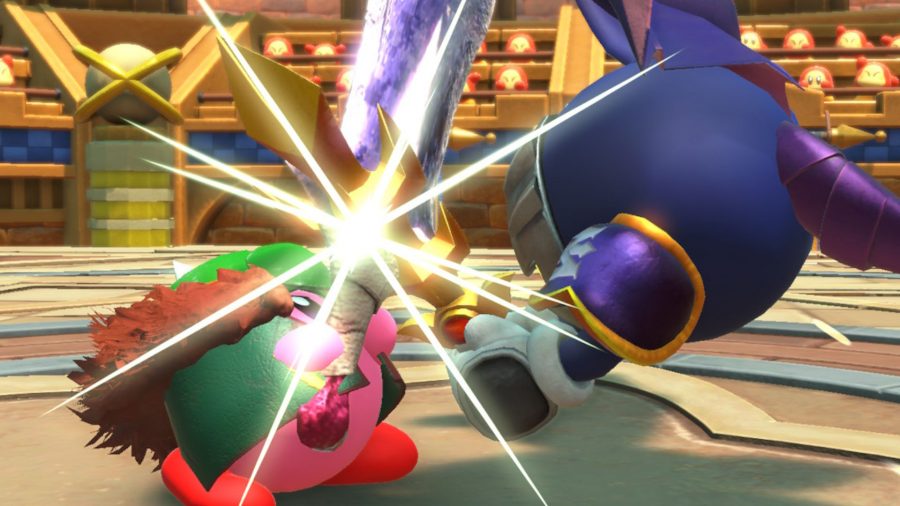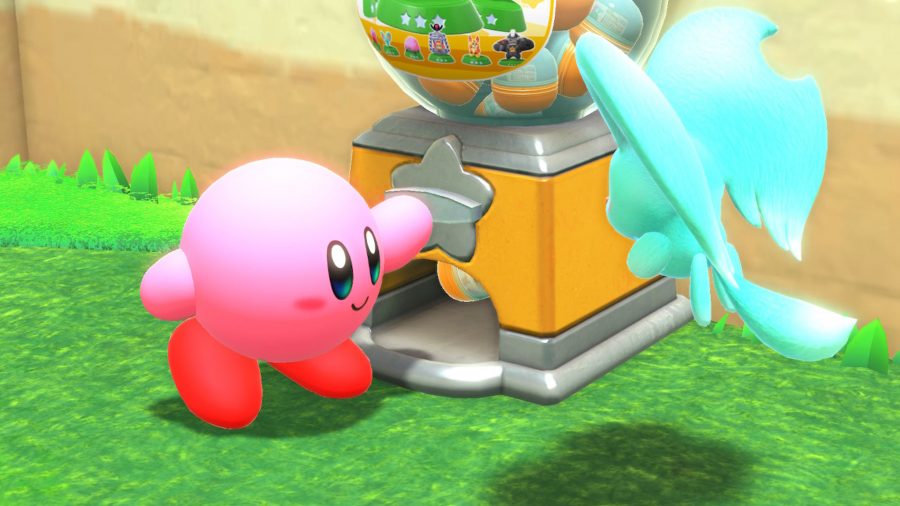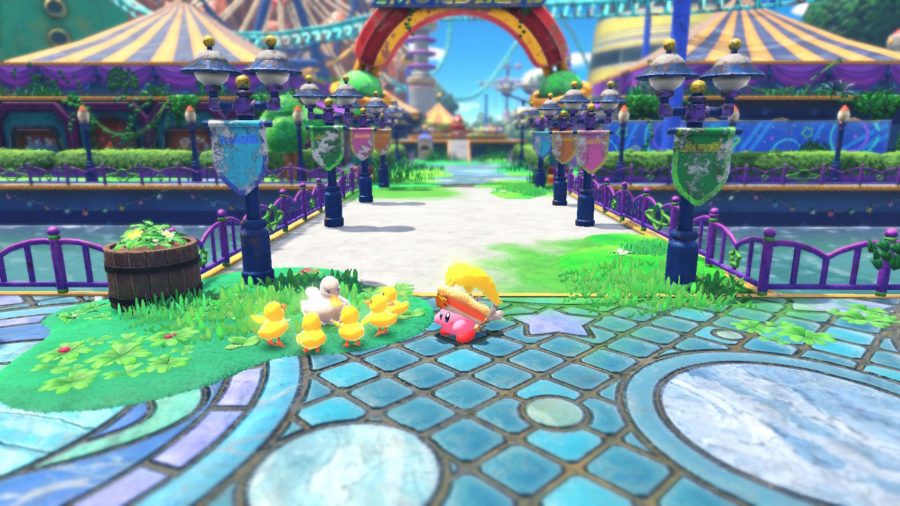Our Verdict
Kirby and the Forgotten Land is a delicious mouthful of puzzling, platforming, adventure-filled fun, with heaps of inventive mechanics, luscious level design, and plenty of challenges to chew on
It’s not often you pick up a game that does everything it sets out to do from the first moment you grab the controller, but Kirby and the Forgotten Land achieves this with effortless grace. It radiates an enamouring sense of nostalgia and childhood wonder, while offering a fresh, unique take on both the platforming genre, and the Kirby series itself.
Our entire team – along with most of the gaming community – were immediately taken with Kirby and the Forgotten Land from its first announcement. As soon as we got our first sneak peek back at the Nintendo Direct in September 2021, watching our favourite little pink mochi ball inhaling cars, vending machines, and more, it was all we could talk about. Delighted by the promise of some wonderfully bizarre shenanigans and what looked to be a true return to form for my beloved Kirb, I found myself counting down the days until I could get my hands on a copy.
Of course, I attempted to temper my expectations – rarely does a new release really capture that old magic and live up to the massive hype generated by the preview material and internet buzz. However, the moment I launched Kirby and the Forgotten Land and dove into the adorable opening cutscene, I knew I was in for a true treat – and I’m not just talking about the abundance of delicious snacks that Kirby so eagerly inhales.
The post-apocalyptic trope has become exceedingly popular over recent years, but it certainly wasn’t a direction I expected to see a Kirby game take. However, as I watched a wormhole open over Dream Land, hoovering up Kirby and pals and transporting them to a dilapidated, seemingly post-human world, I was amazed to see that everything just worked. It’s a truly fresh way to test the limits of Kirby’s powers and get him, the Waddle Dees, and, in turn, the player out of their comfort zones, and I was elated to get to explore this intriguing new world.
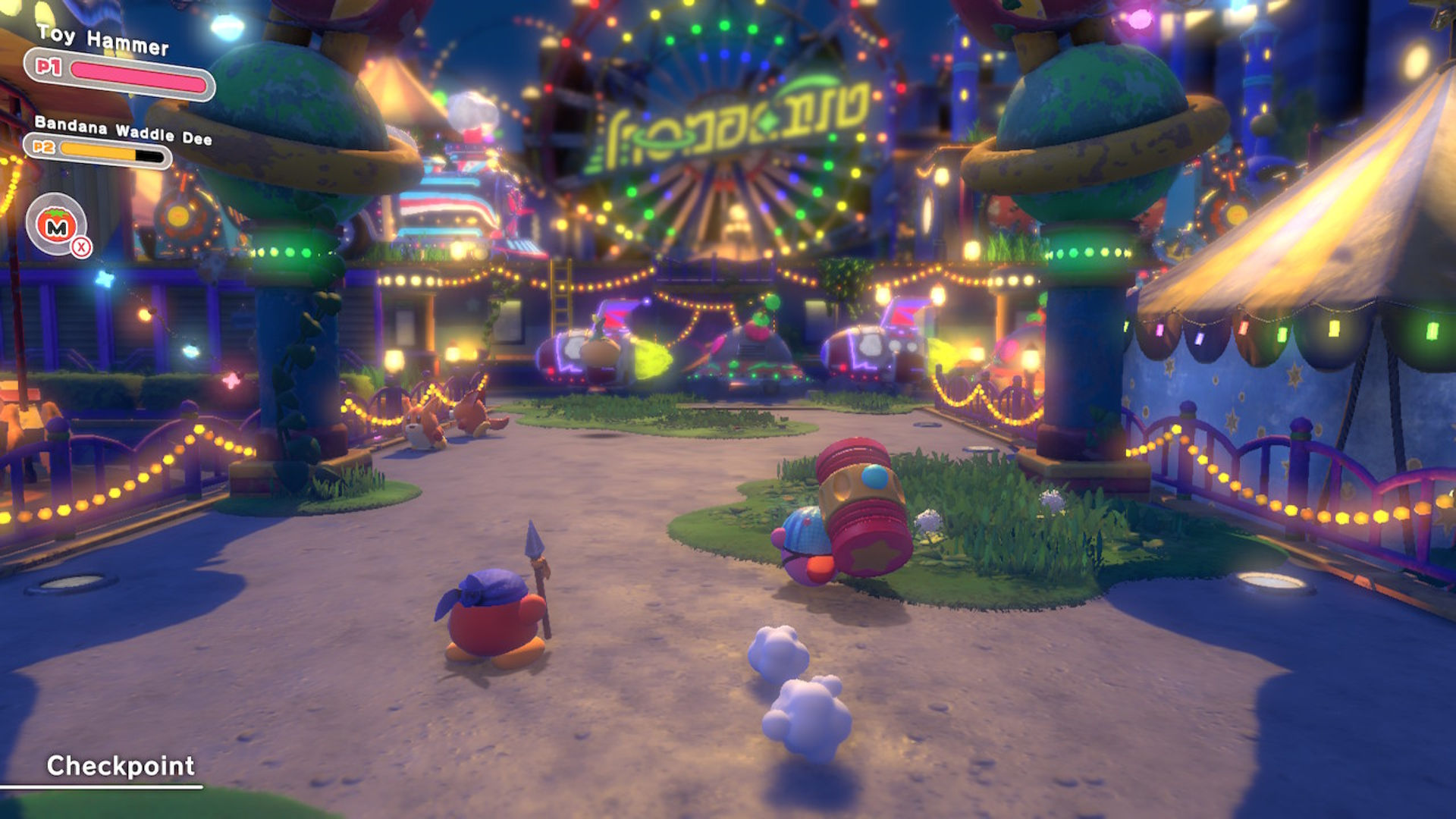 Get it here!
Get it here!
The first thing that strikes you is the stunning visuals. This game looks absolutely gorgeous, no matter what land you’re exploring. From the luscious landscapes of The Natural Plains, to the nebulous neon lights of Wondaria Remains, the vibrancy and attention to detail bring a tangible sense of life to every corner of these post-apocalyptic settings. Never has an abandoned, concrete building half-submerged in the ocean looked so lovely.
The soundtrack is also a delight, borrowing melodies from previous Kirby games and revamping them into fresh, upbeat bops. And the Treasure Road tunes are honestly bangers, taking the music in a techno/house direction that never fails to get me hyped as I hop around impaling pipes as a traffic cone, and rolling over tricky obstacle courses as a pipe.
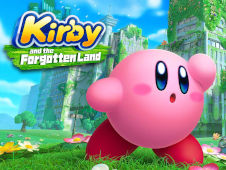 Kirby and the Forgotten Land Kirby and the Forgotten Land $59.99 Buy Now Network N earns affiliate commission from qualifying sales.
Kirby and the Forgotten Land Kirby and the Forgotten Land $59.99 Buy Now Network N earns affiliate commission from qualifying sales.
As an ever-important feature in any platforming game, I’m glad to say that the controls are great, with two layouts to pick from depending on personal preference. They’re easy to get the hang of, and handy little prompts pop up in the bottom corner of the screen whenever a new action is introduced. They feel snappy and responsive, making it easy to adapt and allowing you to focus on the enthralling gameplay rather than hesitantly hovering over buttons, trying to remember which you should press.
The camera is automatic and often quite zoomed out, which isn’t usually suited to my personal preferences, but in a game like this, it’s integral. It’s also done so fluidly, that it’s barely noticeable that you’re not in control – I only occasionally found myself battling a camera around a corner when I was convinced there was some hidden secret just out of sight (there usually wasn’t, but I’m a sucker for exploring every inch of each level).
Combining all the best bits of games like Crash Bandicoot, Rayman Origins, Rayman Legends, and Mario Galaxy, the plot and gameplay follow a tried but true format where you travel from level to level in the overmap, visiting new lands in search of captured Waddle Dees and secret treasures. As you collect more Waddle Dees, you watch Waddle Dee Town develop before your eyes, expanding with new structures and handy features such as a café, an item shop, and more. This all feels truly rewarding, and gives you a stronger drive to help rescue all the missing Waddle Dees – as if their adorable little faces aren’t enough motivation, of course.
Gathering all the missing Waddle Dees, finding all hidden secrets, completing the sometimes infuriatingly tough Treasure Roads within the target times, and getting through every mission adds a wonderful level of challenge to the game. Kirby and the Forgotten Land, as such, offers a fantastic balance between being easy and accessible enough for children and casual players to get through, while still offering a challenge for completionists who want to achieve every goal.
The overall game is pretty short, with only six worlds consisting of four levels and a boss battle each, but the additional minigames, bonus areas, and missions make it worth taking your time with. The missions also add a great amount of replayability to each level, which is needed in such a short but sweet title. Some of them are pretty hard to predict, such as defeating a boss with a specific copy ability that you may not have chosen at the start of the battle, encouraging you to go back and experience the same fight in a different way. So, if you want to earn all the goodies and save all the Waddle Dees, most levels will take you at least two attempts to fully complete.
Each level also comes with its own selection of challenges, secrets, and puzzles that utilise both Kirby’s copy abilities and his new mouthful mode in wonderfully inventive ways. Whether you’re sucking up a staircase to break down walls and trigger switches, or a lightbulb to navigate the dark mazes of Wondaria’s Invasion at the House of Horrors, the consistent introduction of new mechanics keeps you on your toes and adds new excitement to each level, as you work out how best to use the environment around you.
The blueprints that you can find to upgrade your copy abilities only further enhance the constantly evolving gameplay, and I’m filled with childlike joy every time I snag one, eagerly running to poor Mr. Sandbag to test out this fresh take on an existing skill. That guy’s been frozen, burnt, rolled around, and used as target practice way too many times – he’s the true MVP.
Of course, you’re not just fighting Mr. Sandbag. There are plenty of great enemies to test these skills out on, too, as you face off against both familiar faces and fresh beasties anew. Their designs are brilliant, and often so adorable that it makes my heart ache every time I have to smack them with a giant hammer or launch a magma ball at them. The bosses are also brilliant – though I didn’t find them particularly challenging, their movesets and designs are super impressive, and both the way boss levels are laid out, and the exciting changes to the soundtrack add a real sense of anticipation as you enter the ring.
In addition to the main levels, there are plenty of minigames and extras. The previously mentioned Treasure Roads unlock as you progress through levels and gain and upgrade copy abilities, challenging you in a variety of interesting ways in exchange for coins and rare gems used to upgrade your blueprints. Some are simple enough, while others get pretty tough to complete, especially within the target times. They all focus on testing out your skills with the variety of copy abilities and mouthful modes offered in the game, and I think it’s a great way to explore these mechanics while also allowing the more hardcore puzzle proffisionados and platforming prodigies to test their mettle.
Aside from the Treasure Roads, there’s plenty to explore in Waddle Dee Town as it continues to grow. If taking a nap in Kirby’s adorable little house, watching cutscenes in the cinema, upgrading your blueprints at the Waddle Dee Weapon Shop, or redeeming all the latest Kirby and the Forgotten Land codes at Waddle Dee-liveries isn’t enough for you, you can also test your reaction skills at the Waddle Dee Café.
This adorable minigame comes in three difficulty levels, and has you serving up a variety of snacks to Waddle Dees within a short time limit. You have to keep a level head and ensure you get the correct orders out lickety-split to ensure the customer satisfaction doesn’t drop – believe me, a horde of angry Waddle Dees is far more intimidating than even the Meta Knight.
Speaking of Meta Knight, this broody little critter makes an appearance in Waddle Dee Town, too. After rescuing a certain number of Waddle Dees, the Colosseum is unlocked, which has you facing off against multiple waves of bosses, with the final challenge pitting you against the Meta Knight itself. Best of all, if you manage to defeat each level, you get the blueprint to upgrade your standard sword mode into the awesome Meta Knight sword. Not only is this ability powerful, but it also looks even cooler than Bandana Waddle Dee in sunshades, and that’s saying something.
Of course, on top of all the Waddle Dees, coins, and rare gems to collect, there’s also the figures that come in the surprise capsules. Whether gathering them out in the wild or from the gachapon machines in Waddle Dee Town for ten coins a pop, opening one of these little suckers never fails to bring me unbridled joy. They essentially give you that same sense of excitement and anticipation you get from opening a loot box, without the predatory monetisation of real loot boxes – which is honestly a massive win in my books. Plus, looking at all the little figures in your collection and reading their descriptions is a real delight, too, and it’s so satisfying to see the number of figures you own grow.
During my time with Kirby and the Forgotten Land, I also extensively tested the co-op to see if it holds up. Player two takes control of Bandana Waddle Dee, wielding a spear instead of Kirby’s arsenal of copy abilities. While it’s not quite as exciting for player two as they don’t have the range of weapons and attacks that Kirby does, using Bandana Waddle Dee’s spear is plenty of fun, and it can certainly pack a punch. From short, snappy jabs, to aiming and throwing a barrage of spears, to helicoptering around and doing a ground slam, his combat is thoughtfully implemented and doesn’t feel lacking despite not having much variety.
Co-op controls are also well implemented, with easy access to co-op mode from the pause menu at any point. It has an intelligent camera system that, while following player one, doesn’t leave player two in danger by allowing them to roam around offscreen. If Bandana Waddle Dee wanders too far from Kirby, he’s safely transported back to his pal’s side in a ball of white light, and he’s able to pick up items, defeat enemies, and save kidnapped Waddle Dees the same way Kirby is. There’s also a nifty feature where, if one of the players has lower health than the other, they give each other a cute little high five next time they get close to each other, sharing a portion of their HP.
Performance-wise, Kirby and the Forgotten Land runs brilliantly. Both in handheld and docked mode, I noticed very little frame dropping, and load times are short and snappy, so you’re rarely waiting too long to hop back into the action. It makes intelligent use of draw distance, blur, and camera angles to ensure even the most busy and visually impressive scenes are handled well. Naturally, the wonderfully vibrant colours look rich and immersive on the Switch OLED screen, but it still looks absolutely gorgeous on both a standard Switch and a television or monitor.
Overall, I truly can’t sing Kirby and the Forgotten Land enough praises. It’s both a wonderful callback to the golden era of platforming games, and a brilliant, fresh take that introduces a variety of intriguing and inventive features. My only gripe is that I would love it to be longer, but, as mentioned above, with all the extra modes and missions, it still offers plenty of replayability and hours of fun.
This title is truly the perfect mouthful, and is even more delicious than a Kirby Burger or a Mouthful Mode cake – I truly recommend you take a bite.
